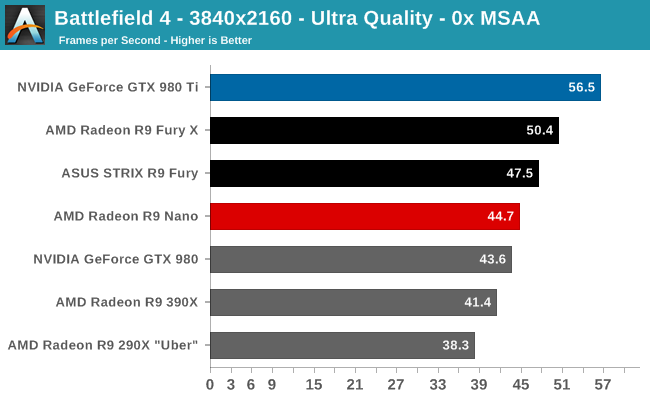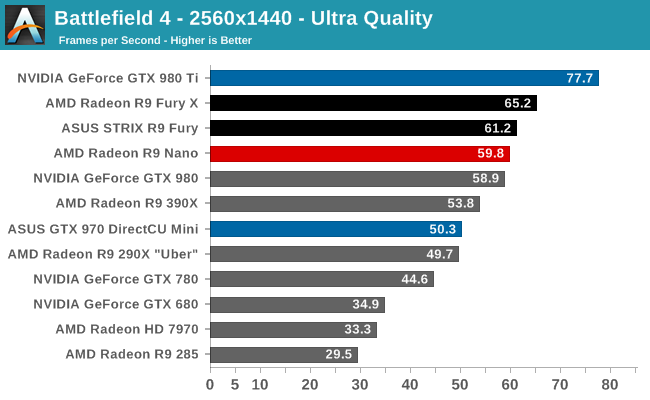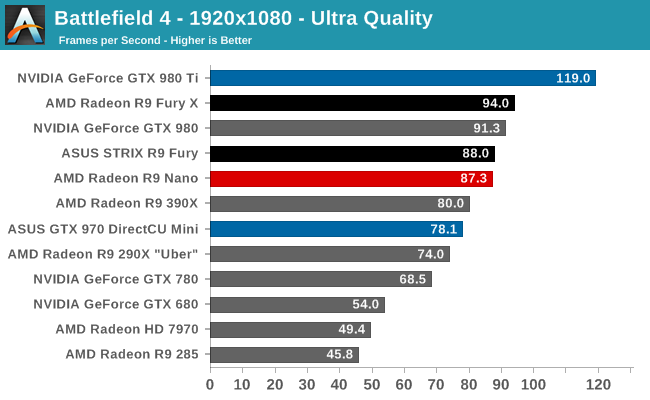The AMD Radeon R9 Nano Review: The Power of Size
by Ryan Smith on September 10, 2015 8:00 AM ESTBattlefield 4
Kicking off our benchmark suite is Battlefield 4, DICE’s 2013 multiplayer military shooter. After a rocky start, Battlefield 4 has since become a challenging game in its own right and a showcase title for low-level graphics APIs. As these benchmarks are from single player mode, based on our experiences our rule of thumb here is that multiplayer framerates will dip to half our single player framerates, which means a card needs to be able to average at least 60fps if it’s to be able to hold up in multiplayer.




Like the other Fiji cards, AMD is promoting the R9 Nano in part on its 4K capabilities. And while we disagree that this card is suitable for 4K gaming based on its sub-Fury performance, we’re including 4K results anyhow to serve as a point of comparison.
In any case Battlefield 4 is often a good indicator of general card performance, and for the R9 Nano this is no exception. What we find is that the R9 Nano trails the other Fury cards in all cases. However to our initial surprise, the R9 Nano sticks rather close to the R9 Fury. The petite powerhouse trails the R9 Fury by only 1-6%, which for the record is a smaller gap than we were expecting.
While the R9 Nano packs a full Fiji GPU, AMD has to pull back on clockspeeds to hit their power targets; in the case of Battlefield 4 this is an average clockspeed of just 879MHz at 2560x1440. Given this we had been expecting the R9 Nano to deliver around 85-90% of the performance of the R9 Fury (and about 80% of the R9 Fury X), based on the assumption that average clockspeeds would be closer to 800MHz. So the fact that the R9 Nano starts off as close to the R9 Fury as it does – even if it’s still trailing it – is a pleasant surprise.
Otherwise with performance still clearly occupying a position as a “3rd tier” Fiji card, I’m not sure if anything about these results should be surprising. On a price/performance basis AMD is not intending to be competitive with other $650 cards, so the R9 Fury X and GTX 980 Ti are of course on the top of the heap. What you get instead is a card that delivers around 90% of R9 Fury X’s performance in BF4 with much less power consumption.
Moving on, compared to the lower power and smaller cards, the R9 Nano is as expected a clean sweep. Demonstrating the virtues of a wide and lower clocked processor’s ability to deliver strong performance without requiring extreme power, everything from the R9 285 to the GTX 980 trails the R9 Nano here. Compared to the GTX 970 Mini in particular, the R9 Nano is 12-26% faster depending on the resolution.
The one potential problem here for the R9 Nano is the GTX 980. Though not a Mini-ITX card, the GTX 980’s power consumption is going to be fairly close to the R9 Nano’s, definitely more so than GTX 970’s. From a power efficiency standpoint it’s the GTX 980 that poses the greatest challenge to the R9 Nano, and while it’s ahead of the GTX 980 in this case at 2560x1440 and higher, it’s a sign that AMD should be worried about what could happen if an NVIDIA partner produced a Mini-ITX GTX 980.










284 Comments
View All Comments
Oxford Guy - Tuesday, September 15, 2015 - link
I'll leave you to ponder this.Gunbuster - Thursday, September 10, 2015 - link
What a great little card for a miniature $3000+ boutique HTPC. Oh wait, no HDMI 2.0 for 4K.Asomething - Thursday, September 10, 2015 - link
you know you can add a passive dp-hdmi adapter right? its hard to find one that supports dp 1.2 but they exist. if $3000 plus an extra $30 is too much maybe dont make a $3000 HTPC.Gunbuster - Thursday, September 10, 2015 - link
Did you mean the fabled DP to HDMI 2.0 active converter that AMD keeps saying the channel will have "soon"Also once soon arrives we will have to see how well it actual works and if it introduces any input lag.
Fallen Kell - Thursday, September 10, 2015 - link
No, you can't buy a passive dp-hdmi adapter that supports proper HDMI 2.0+HDCP 2.2 that is needed for proper video content playback. These devices still do not exist. Parade Technologies has made an announcement on a chip/device to do this job, but they do not make end-user/consumer goods (think AMD/Nvidia when they do not make a reference card) and simply sell the chips to a vendor that makes the devices. They announced the product August 10th, 2015. It will be a good 4-6 months still before we see a vendor decide to make a product that uses that chip.ThomasS31 - Thursday, September 10, 2015 - link
So GTX980 Performance for GTX980Ti price... well.Some will probably interested in it... but this is "mispositioned" atm.
rhysiam - Thursday, September 10, 2015 - link
Kind of missing the point there I think. It's also slower and more expensive than a Fury (nonX), so if you don't want/need a small card then of course the Nano makes no sense whatsoever.The whole point of this card is it's size and (relative for AMD) efficiency, but naturally you need to either pay a little more or accept lower performance at the same price-point... that's the tradeoff.
TheinsanegamerN - Thursday, September 10, 2015 - link
but, if efficiency and size is a major selling point, why choose this over the 970 mini, which is half the price and uses less power?This makes the nano's market people who want a small mini itx card (so a HTPC case, as most itx gaming cases can take full size cards), which is efficient, but can't fathom buying an nvidia card, despite using less power while still performing well, and are willing to fork over 980ti levels of cash for 980 performance, to drive a 4k or 1440p displayport monitor (as there is no hdmi 2.0 on nano, so 4k tvs are out, and 1080p would favor the 970).
That's, like, a niche of a niche of a niche of a niche. Not really a major money making market for AMD.
przemo_li - Thursday, September 10, 2015 - link
But less performance too.I do not get why people get distracted with "energy efficiency" at all.
Its KING OF THE JUNGLE gpu. It's all about performance.
TheinsanegamerN - Thursday, September 10, 2015 - link
When you are building a small HTPC, which is the market AMD is aiming for with the nano, efficiency is very important. All that heat has to go SOMEWHERE. a lower consumption part won't produce as much heat. If you want a KING OF THE JUNGLE gpu, why are you looking at nano, and not titan x or fury x?